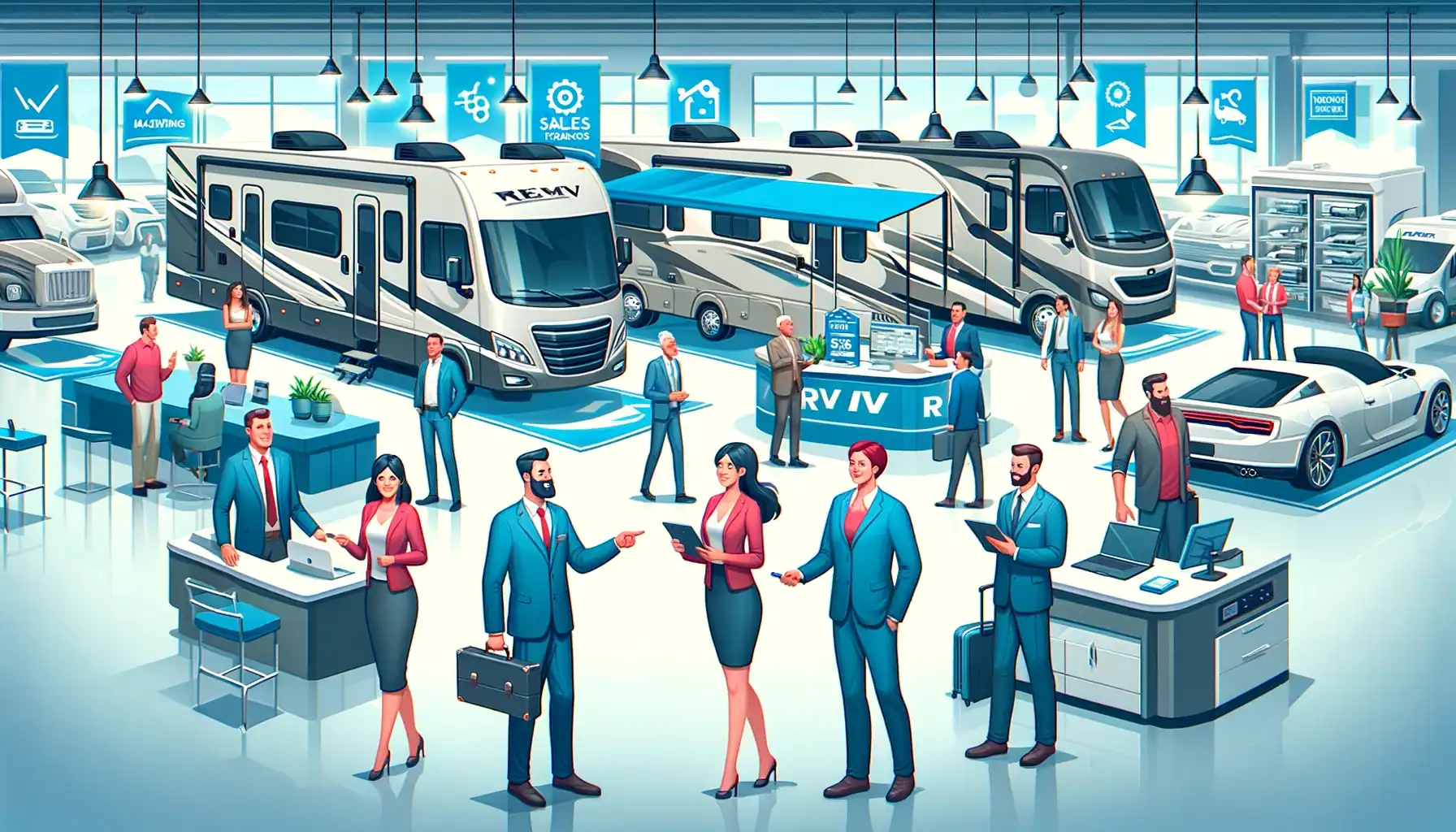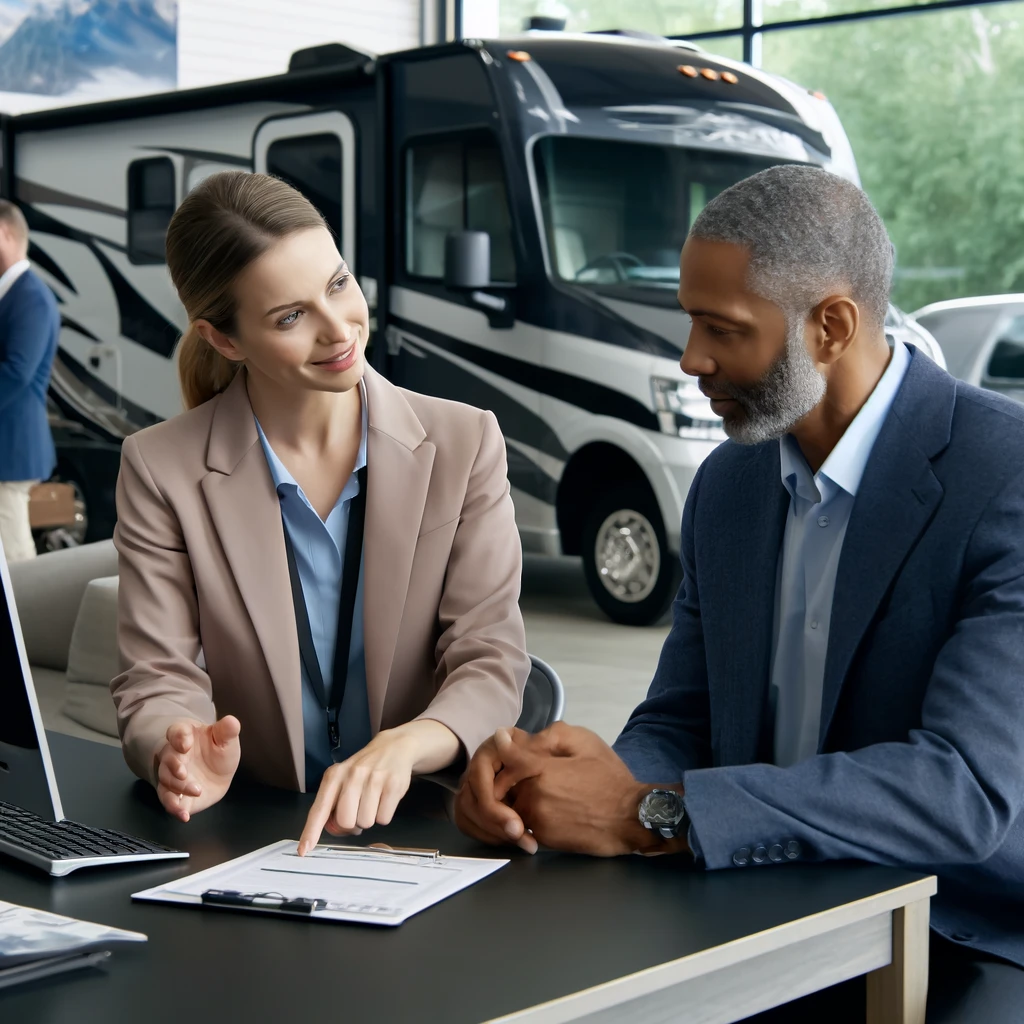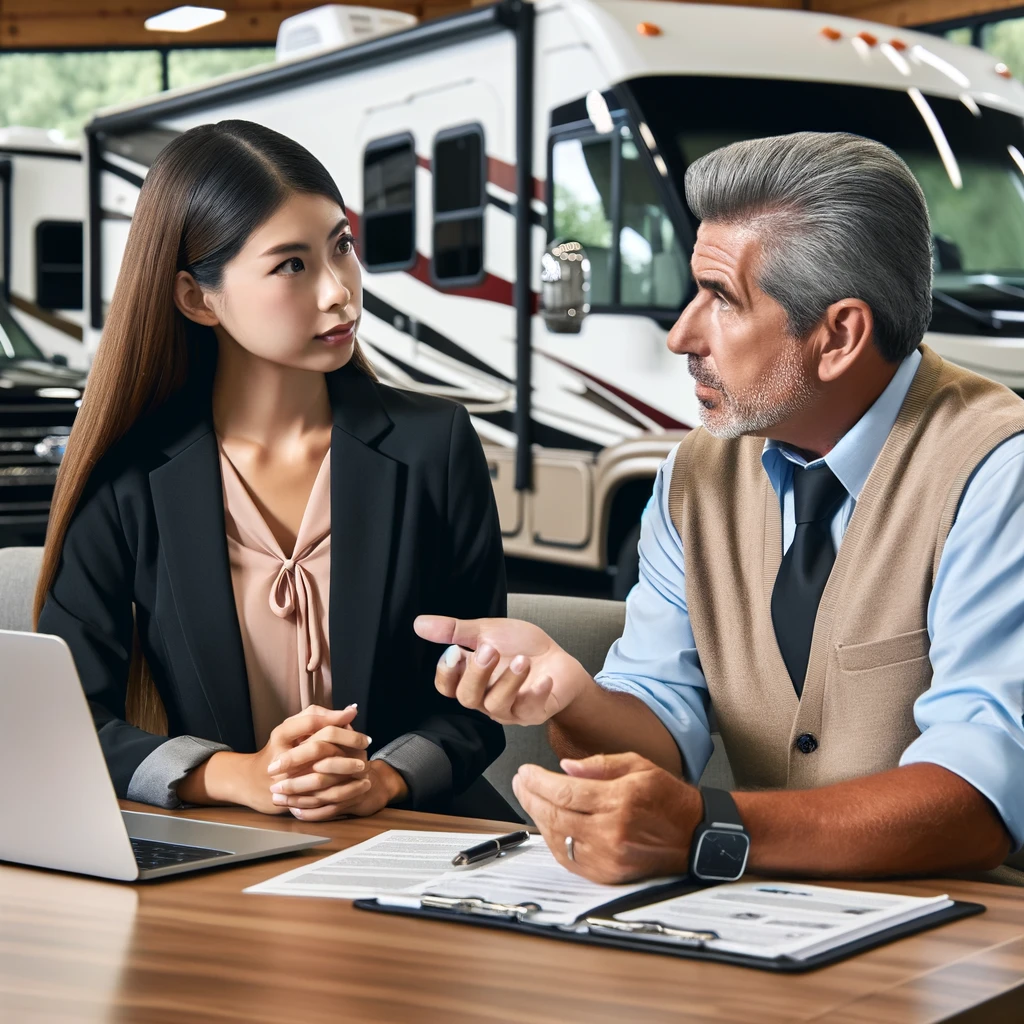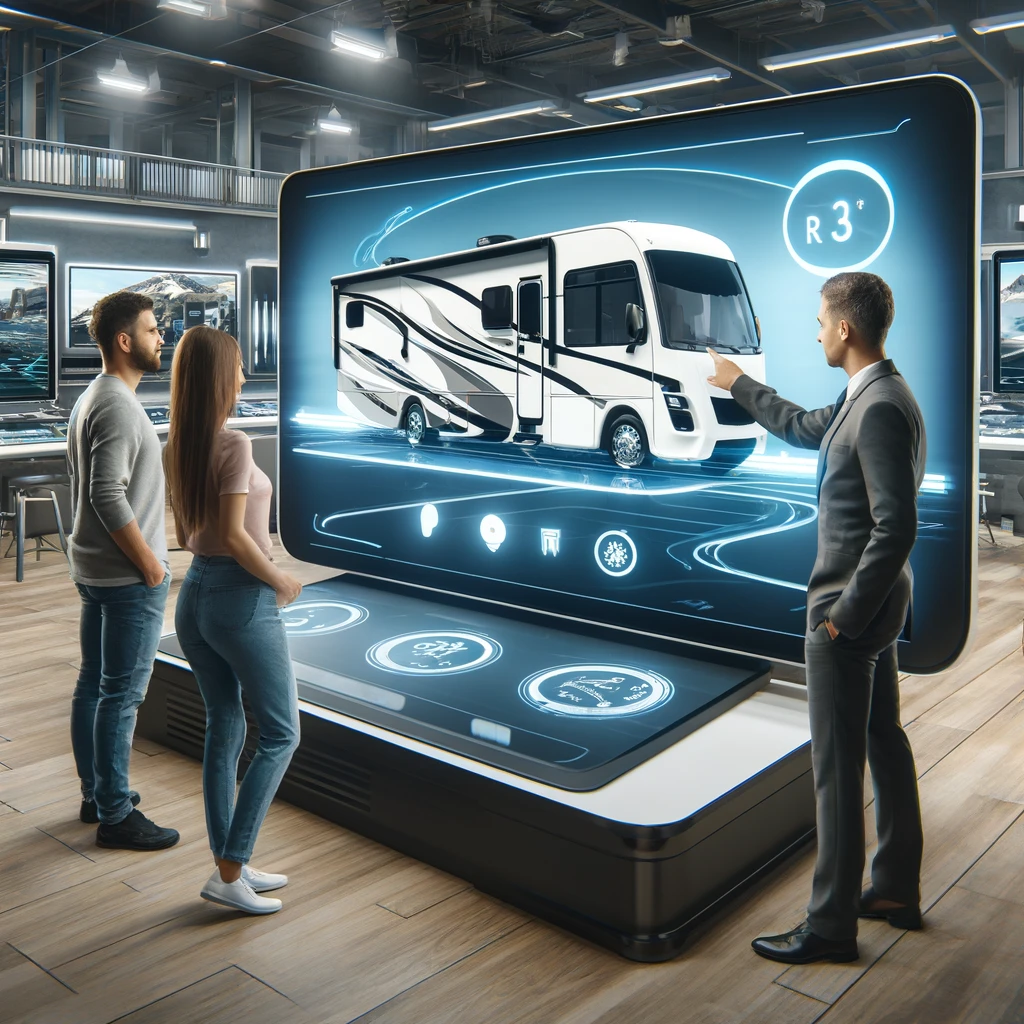
Maximizing RV Sales: A Guide to 6 Effective Strategies
April 23, 2024
Jump to Section:
Implementing robust sales strategies is crucial in navigating the complexities of the RV market. These strategies help build strong customer relationships, understand and meet customer expectations, and ultimately drive sales success. This guide will explore six essential sales tips that can transform how dealerships engage with and sell to potential RV buyers.
The following sections will delve into these six tips, providing practical advice on how to implement them to meet and exceed sales targets while ensuring customer satisfaction remains at the heart of every transaction.
Tip 1: Master the Art of the First Impression

The first interaction between a salesperson and a potential RV buyer can significantly influence the outcome of the sales process. Making a solid first impression is crucial as it sets the tone for all subsequent interactions and can decide whether a customer feels comfortable and eager to proceed.
Examples of Engaging Opening Lines and Welcoming Gesturesres
To effectively engage customers from the outset, consider these opening lines and gestures:
Opening Lines:
- "Welcome to [Dealership Name]! What brings you in today?"
- "It’s great to see you! Are you excited to explore our latest RV models?"
- "Hello, I’m [Your Name]. I look forward to helping you find the perfect RV for your adventures."
Welcoming Gestures:
- Provide a brief tour of the dealership or the online platform.
- Offer a welcome brochure or a digital welcome packet with information about the dealership and current inventory.
- Introduce them to key staff members who can assist them during their visit.
Employing these best practices in greeting and engaging customers will help establish a positive and inviting atmosphere, making potential buyers more receptive to your sales efforts and setting the stage for a successful interaction.
Tip 2: Effective Discovery and Needs Analysis

Understanding your customer’s needs and preferences is fundamental to successful RV sales. Effective discovery and needs analysis help to identify what the customer is looking for and establish a foundation for personalized service, which can significantly enhance customer satisfaction and increase the likelihood of a sale.
Techniques for Effective Questioning
To effectively uncover the needs and desires of potential buyers, salespeople should employ a variety of questioning techniques:
- Open-Ended Questions: Encourage customers to express their thoughts and feelings about what they are looking for in an RV. Questions like "What kind of adventures are you planning?" or "What features are most important to you in an RV?" can open up the conversation.
- Probing Questions: Once a general idea has been established, use more specific questions to delve deeper into the customer's requirements, such as "How many people will typically travel with you?" or "What is your preferred length of RV?"
- Reflective Questions: Confirm that you understand the customer’s statements correctly. For example, "So, you need an RV that’s easy to park and maneuver in urban areas, correct?"
Utilizing CRM and Other Tools
Leveraging technology can significantly enhance the discovery process:
- CRM Systems: Use Customer Relationship Management (CRM) systems to record and analyze customer interactions and data. This can help tailor conversations based on the customer's previous engagements and preferences.
- Analytical Tools: Employ data analytics tools to understand broader trends and preferences among your customer base, which can inform more strategic sales approaches.
The Role of Active Listening
Active listening is crucial in the discovery phase. It involves not just hearing but understanding and responding appropriately to a customer’s needs:
- Acknowledgment: Show that you are listening by nodding or using verbal affirmations like "I see" or "That makes sense."
- Clarification: Ask for clarification to avoid misunderstandings, demonstrating to the customer that their input is valued and considered.
- Summarization: Recap what the customer has shared to confirm understanding and show that you are engaged in the conversation.
Implementing these techniques in the discovery and needs analysis phase will enable salespeople to understand better and meet each customer's unique needs, paving the way for more effective and successful RV sales.
Tip 3: Demonstrating the Product Effectively

A practical product demonstration is crucial in the RV sales process. It transforms abstract features into tangible benefits that customers can see, feel, and experience. This step is not just about showing what the RV has to offer but also about aligning its features with the customer's specific interests and lifestyle aspirations.
Strategies for Showcasing RV Features
To effectively demonstrate the RV, salespeople should:
- Tailor Demonstrations to Customer Interests: Begin by revisiting what you’ve learned about the customer's needs and preferences. Highlight features of the RV that specifically address those points. For instance, if a customer values compactness and maneuverability, showcase models that are easier to drive and park.
- Use Demonstrative Tools and Technology: Employ virtual tours, augmented reality (AR), or detailed videos showing the RV in different scenarios and settings. This can help customers visualize themselves using the RV in their own life.
Importance of Hands-on Demonstrations and Test Drives
Hands-on experiences are invaluable:
- Engage Customers with Interactive Demos: Allow customers to physically explore the RV's different features. Let them operate the technological enhancements, layout configurations, and storage solutions.
- Facilitate Test Drives: Offer customers the opportunity to drive the RV. This not only gives them a feel for the vehicle but also helps them build confidence in their purchase decision.
Highlighting Benefits Over Features
To connect more deeply with the customer, focus on benefits rather than just features:
- Connect Features to Lifestyle Benefits: Explain how every feature enhances the customer's lifestyle. For example, if an RV has solar panels, discuss how this feature allows for longer off-grid adventures without needing external power sources.
- Use Emotional Appeal: Share stories or testimonials of how similar features have enhanced other customers' experiences. This helps illustrate the features' real-life advantages.
By focusing on practical demonstrations that align with customer interests and highlight the practical benefits of owning an RV, salespeople can significantly enhance the appeal of their products and increase the chances of closing a sale.
Tip 4: Addressing Objections and Closing Techniques

Successfully addressing customer objections and employing effective closing techniques are critical skills for any salesperson, especially in the RV industry, where purchases can represent significant financial and emotional commitments.
Common Customer Objections and How to Prepare Responses
Objections are a natural part of the sales process, and being prepared with thoughtful, well-informed responses can turn potential deal-breakers into opportunities for reassurance and further engagement:
- Price Concerns: These concerns are often the most common objections. Be ready to justify the cost with the RV's value, discuss financing options, or show comparably priced alternatives.
- Need for Consultation: Customers often wish to consult with family or significant others before deciding. Encourage this as a positive step and offer comprehensive information they can take home or send digitally.
- Uncertainty about Features: If customers hesitate about whether the RV meets all their needs, reiterate key features or show alternative models that might better match their requirements.
Techniques for Moving from Discussion to Decision-Making
Guiding a customer from casual discussion to making a decision is an art that involves subtle cues and effective questioning:
- Summarize the Benefits: Regularly summarize the RV's benefits in relation to the customer’s expressed needs to keep the advantages top of mind.
- Trial Closes: Regularly summarize the RV's benefits about the customer’s expressed needs to keep the advantages at the forefront of the customer's mind.
- Create a Sense of Urgency: Explain any time-sensitive discounts or the model's popularity without pressure, which might require quicker decision-making.
Closing Strategies That Ensure a Commitment Without Pressure
The final stage of closing should feel natural and pressure-free to the customer:
- Offer Choices: Providing options between different models or packages can empower the customer, making them feel in control of the decision.
- Use Incentives: Mention any incentives, such as a limited-time discount, added accessories, or service packages, that make closing more attractive.
- Assurance and Reassurance: Reiterate post-sale support and warranty services to ensure the customer receives ongoing support.
By mastering these techniques, RV salespeople can effectively address objections and guide customers toward making confident decisions, ultimately leading to successful and satisfying closes.
Tip 5: Follow-Up and Relationship Management

Effective follow-up and relationship management are crucial in enhancing customer satisfaction and driving retention and referrals. After an RV sale, the period offers a significant opportunity to build a lasting relationship with the customer, ensuring they feel valued and supported.
Importance of Post-Sale Follow-Up for Customer Satisfaction and Retention
Post-sale follow-up is essential for several reasons:
- Ensuring Satisfaction: Contacting customers after their purchase to ensure they are satisfied with their RV can address any immediate concerns and provide an opportunity to resolve issues promptly.
- Building Loyalty: Regular follow-up helps build a relationship beyond the initial sale, fostering loyalty, which can lead to repeat business and referrals.
Strategies for Effective Communication and Maintaining Contact
Maintaining effective communication after the sale involves:
- Scheduled Check-ins: Set up a schedule for follow-up calls or emails at regular intervals (e.g., after one week, one month, and six months). These check-ins can provide maintenance tips, remind customers about service schedules, and keep customers informed about new offers or products.
- Personalized Communication: Tailor communication to each customer's specific interests and preferences. Personal touches can include birthday or holiday cards, personalized emails, and invitations to exclusive dealership events.
Using Feedback and Reviews to Improve Service and Offerings
Feedback is a powerful tool for improvement:
- Request Reviews: Actively ask customers for reviews and feedback on various platforms. This not only helps in boosting online presence and credibility but also provides insights into areas for improvement.
- Leverage Feedback: Use the feedback to refine your service offerings and customer interactions. If a particular aspect of the RV or service is frequently praised or criticized, consider how you can enhance or correct this in your future sales approach.
Implementing these follow-up and relationship management strategies ensures that customers remain engaged and satisfied with their purchases, thereby enhancing your dealership's overall success and reputation.
Tip 6: Leveraging Technology for Sales Enhancement

In today’s digital age, leveraging technology is not just an advantage but a necessity for enhancing sales efficiency and customer satisfaction. Various technological tools for RV dealerships can streamline processes, improve customer interaction, and drive more sales.
Overview of Technology Tools Like CRM Systems, Mobile Apps, and Virtual Tours
Technology tools play a crucial role in modernizing the RV sales process:
- CRM Systems: Customer Relationship Management (CRM) systems help manage customer data, track interactions, and automate marketing. They provide invaluable insights into customer preferences and behavior, which can be used to tailor sales approaches.
- Mobile Apps: Mobile apps can offer customers the convenience of browsing RV inventories, booking appointments, and communicating with sales representatives directly from their smartphones.
- Virtual Tours: Virtual tours allow customers to explore RV models in detail from the comfort of their homes. They provide a 360-degree view of interiors and exteriors and often include clickable areas for more information on specific features.
How Technology Can Streamline the Sales Process and Enhance Customer Interaction
The integration of technology in the sales process offers significant benefits:
- Efficiency: Automation tools can handle repetitive tasks such as sending follow-up emails or updating customer records, freeing sales staff to focus on direct customer engagement.
- Personalization: Advanced analytics and data collection enable a more personalized sales experience, allowing salespeople to recommend products that meet each customer's specific needs and preferences.
- Engagement: Digital platforms can facilitate more frequent and meaningful customer interactions, maintaining engagement throughout the sales cycle and beyond.
Examples of Technology in Action Within the RV Industry
Real-world applications of technology in the RV industry illustrate its impact:
- Interactive Configurators: Some dealerships offer online configurators that allow customers to customize their RV from various options, seeing real-time updates and pricing adjustments.
- Customer Portals: Online customer portals allow RV owners to access manuals, service schedules, and direct support, enhancing the ownership experience.
- Social Media Integration: Using social media platforms to share updates, run promotions, and engage with customers can increase visibility and attract new buyers.
By effectively leveraging these technologies, RV dealerships can enhance operational efficiency and create a more dynamic and satisfying customer experience.
As we conclude our exploration of the six essential sales tips for selling more RVs, it's clear that each strategy plays a crucial role in enhancing the sales process and boosting customer satisfaction. From mastering the art of the first impression to leveraging advanced technologies, these strategies are designed to meet the diverse needs of today's RV buyers and set your dealership apart in a competitive market.
Recap of the Six Sales Tips and Their Benefits
- Master the Art of the First Impression: Sets a positive tone and builds immediate rapport.
- Effective Discovery and Needs Analysis: Ensures a personalized and informed sales approach.
- Demonstrating the Product Effectively: Highlights how the RV meets the customer’s lifestyle and needs.
- Addressing Objections and Closing Techniques: Overcomes barriers and facilitates confident decision-making.
- Follow-Up and Relationship Management: Enhances customer loyalty and encourages repeat business.
- Leveraging Technology for Sales Enhancement: Streamlines processes and enriches customer interactions.
Encouragement to Implement These Strategies
Implementing these tips can lead to measurable sales performance and customer engagement improvements. Each strategy contributes to a more efficient and successful sales cycle and enhances the overall customer experience, making them feel valued and understood.
Final Thoughts on Continuous Improvement of Sales Techniques
The RV sales market is continually evolving, and so should your sales techniques. Staying adaptable and forward-thinking, constantly seeking feedback, and embracing new technologies are essential for staying competitive and relevant. By committing to ongoing learning and improvement, you can ensure that your sales strategies remain effective, no matter the changes in the market landscape.
Embrace these strategies with confidence and watch as they transform your sales figures, customer satisfaction, and dealership reputation.
Boost your RV sales with DealerClick's RV Dealer Software. Designed to simplify management and enhance customer service, our system helps you efficiently manage inventory and compliance, ensuring smoother sales and superior customer interactions.

